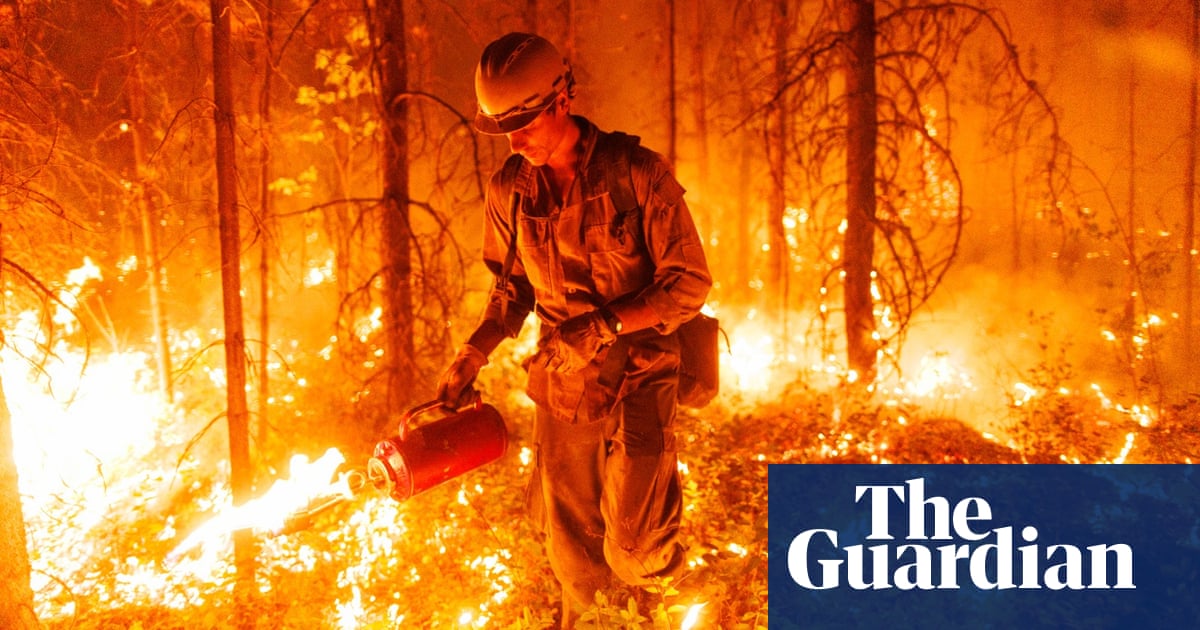
Canada’s extraordinary year of wildfire finally appears to be slowing down, leaving behind a weighty legacy of charred northerly forests, acrid smoke and a huge pulse of carbon emissions that will have reverberations for the climate around the world.
Fire ravaged Canada in 2023 like no other year, by a stupendous margin. A record 45.7m acres (18.5m hectares) went up in flames, an area about twice the size of Portugal, shattering the previous annual record nearly three times over. From the spring onwards, more than 6,500 fires sprang up, unusually, across the whole country, tearing through Nova Scotia in the east to British Columbia in the west.
The fires were largely centered on Canada’s vast boreal forests, a trove of habitat for creatures such as moose, bears and songbirds and a crucial carbon bank that blankets an area larger than India, representing about a quarter of the world’s remaining intact forest.
Most of the blazes were in remote areas – but there were two firefighter deaths in July and numerous evacuations, most memorably the 20,000 citizens of Yellowknife, the capital of the Northwest Territories, who had to flee their homes in August as multiple fires converged upon the city.
Fire has always been a feature of Canada’s forests but experts say this year was not only a staggering departure from previous norms but also a grave omen of the sort of conditions that will be wreaked by the climate crisis, which is helping spur larger, fiercer wildfires through elevated temperatures and altered rainfall patterns.
“It has been an exceptional, epic year,” said Stephen Pyne, a fire historian at Arizona State University. “We are watching mythology become ecology – it’s a slow-motion Ragnarök. We’ve had ice ages in the past but we are now living through what I call the ‘pyrocene’. Imagine an ice age but instead of ice as a forming feature, we have fire.
“This is clearly a case of climate change adding energy to the system, magnifying the boom and bust of the boreal forest. We may be witnessing a change of state, a change in the character of this environment.”
At least 100 of Canada’s fires this year have been so fierce as to create their own weather via pyrocumulonimbus clouds, or “fire storm clouds”, which can stretch 200 miles (320km) wide and carry ash and other debris upward and unleash lightning that can trigger multiple other fires that immolate more trees.
The sheer intensity of some of these blazes means it is not clear whether the dominant fir and spruce trees in the boreal forest will come back as before – it may be a different, more flammable mixture of vegetation that regrows in their place.
“We are seeing an environment adapted to ice being driven off to be replaced by one that is adapted to fire,” said Pyne. “If you have these sort of fires, these sort of monsters, you start to see quite big changes.”
The impact of the fires was also felt far beyond Canada’s borders, causing plumes of smoke that turned New York City’s skies a dystopian orange in June and as recently as last month caused hazy skies as far away as Florida. People in cities in eastern Canada and the north-east US were forced to put on masks discarded since the Covid pandemic amid some of the worst air quality in the world, as hospitalizations for conditions such as asthma spiked.
The impact upon the world’s climate will be even more significant than this. According to data from the European Union’s satellite monitoring service, more than 1.7bn tons of planet-heating gases have been released this year by the enormous fires – about three times the total emissions that Canada, a major fossil fuel-producing nation, itself produces each year.
Such huge emissions, eclipsing in a single year any measure, however ambitious, to cut pollution from cars or factories by a country like Canada, are a major drag upon efforts to stem the climate crisis. The majestic boreal forests, much like the Amazon rainforest that now emits as much carbon as it sucks up and is tipping towards becoming a savannah, suddenly appear to be a danger to the world’s climate rather than a key safeguard.
“People used to see places burn on the news but now they are feeling it with smoke where they live,” said Pyne. “Who would’ve cared about fires in northern Quebec before? But now it’s suddenly smoky in major metropolitan areas and people have to care. It’s all very real for them.
“The forest isn’t our friend any more,” he added. “This was supposed to be a natural reservoir, our carbon bank, but now the bank isn’t stable. There’s a bank run. It is going to burn, as well as the peat below the ground that is also a huge store of carbon. It’s potentially a carbon timebomb.”
For Canada, the challenge of maintaining its huge forests in an age of rapid climate breakdown looms large. The country has about 10% of the world’s forests and a third of this land has burned in the past 40 years. Even as temperatures plummet and snow starts to arrive over winter, many of the outbreaks will continue to smolder underground as “zombie” fires, possibly then rearing up again next year.
Fire is now a near-constant. This year’s extremes have severely taxed firefighters, pushed to the brink of exhaustion battling flames in areas that had to be protected while other, more remote, fires were left to burn, spewing out carbon.
“This year has just been totally unprecedented,” said Mélanie Morin, a spokeswoman for Sopfeu, a firefighting organization in Quebec, which smashed its record for the area burned in a year. The tone for Quebec’s summer was set by a series of lightning strikes in June that set off dozens of fires that firefighters, some of them volunteers from as far as France and South Korea, struggled to contain.
“Everyone worked very hard this summer, everyone was tired with the consecutive shifts,” Morin said. “We are starting to see the consequences of tiredness and the effect on people’s mental states.
“This was something new for eastern Canada. There is a kind of new consciousness that fires exist in this part of the country. People are more aware of it. Those images of the smoke in New York City were shocking but this is the cause and effect of an unprecedented amount of fire.”












